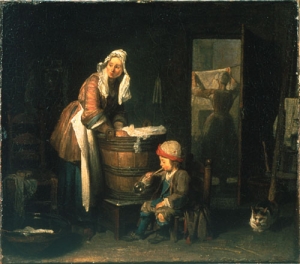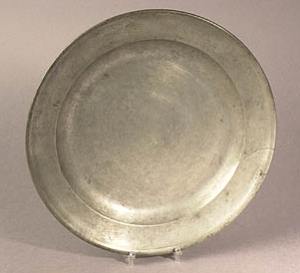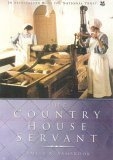-
History of:
- Resources about:
- More:
- Baby walkers
- Bakehouses
- Bed warmers
- Beer, ale mullers
- Besoms, broom-making
- Box, cabinet, and press beds
- Butter crocks, coolers
- Candle snuffers, tallow
- Clothes horses, airers
- Cooking on a peat fire
- Drying grounds
- Enamel cookware
- Fireplaces
- Irons for frills & ruffles
- Knitting sheaths, belts
- Laundry starch
- Log cabin beds
- Lye and chamber-lye
- Mangles
- Marseilles quilts
- Medieval beds
- Rag rugs
- Rushlights, dips & nips
- Straw mattresses
- Sugar cutters - nips & tongs
- Tablecloths
- Tinderboxes
- Washing bats and beetles
- Washing dollies
- List of all articles
Subscribe to RSS feed or get email updates.
[Ash from the English West Country]
They burnt fern or bracken and then took the ashes "which they make fine and Rowle them up in Balls and so sell them or use them all the year for washing and scouring, and send much up to London.
Marjorie and CHB Quennell, quoting Celia Fiennes' late 17th century journal in A History of Everyday Things in England, 1918
Washing & cleaning for a duke
Scrubbing floors and laundry at Bedford House
 Mrs.
Bruce was housekeeper at the
Duke of Bedford's London home in the late 17th century. It was a responsible
job overseeing domestic arrangements in a large mansion*, but she didn't know how
to write. She dictated her part of the household accounts, and these lists of expenses
give us some idea of the flurry of scrubbing and laundering that happened before
and after the family's annual visit to London. (There were sometimes lesser visits
too, when the duke travelled without his wife.)
Mrs.
Bruce was housekeeper at the
Duke of Bedford's London home in the late 17th century. It was a responsible
job overseeing domestic arrangements in a large mansion*, but she didn't know how
to write. She dictated her part of the household accounts, and these lists of expenses
give us some idea of the flurry of scrubbing and laundering that happened before
and after the family's annual visit to London. (There were sometimes lesser visits
too, when the duke travelled without his wife.)
Casual domestic labour in London cost the household one shilling (1s) or eighteenpence (1s 6d) a day. These wages went to un-named women who worked for a few days cleaning floors and windows, scouring pewter, and laundering linen. Their counterparts at the family's country home, Woburn Abbey, lived in estate cottages and were known by name: Goodwife Goffe, Widow Whitbread.
In 1675 Mrs. Bruce's housekeeping expenses included:
| For washing sheets and napkins before the great wash when the two masters was in town | 2s | ||
| For four pounds of soap | 1s | ||
| For six pounds of candles | 2s 6d | ||
| For three women one day to wash | 4s 6d | ||
| A woman two days to help dry up the linen | 3s | ||
| For oil, ashes, and sand to scour | 1s 8d | ||
| A woman to scour two days | 3s | ||
| For washing of twelve pair of sheets at 4d per pair | 4s | ||
| For two pounds of soap to scour the great room | 6d | ||
| For nine pounds of soap | 2s 3d | ||
| For four mops | 4s | ||
| For Fuller's earth and sand to scour the rooms | 1s 8d | ||
| A woman six days to help to wash all the rooms after the workmen left the house | 6s | ||
| A woman six days for scouring and washing the rooms and cleaning the irons against the family's coming to town | 6s | ||
| A woman to help air the bedding when the family came to town | 2s |
 When
the family returned to Buckinghamshire there were more bills, including:
When
the family returned to Buckinghamshire there were more bills, including:
| For soap for the great wash when the family left London | 4s 6d | ||
| For two women to wash after his lordship's being in town | 3s | ||
| A woman four days to help make clean the house when the family went out of town | 4s |
Were any of the well-scoured pewter plates and mugs used by the duke and his family, or were they just for the retinue of footmen, stable boys, pages, maids etc.? Silver for the dining table along with other fine household goods - luxurious bedding, for instance - travelled to London just ahead of the family.
Some maids travelled with this convoy of carriers' carts and wagons, while menservants rode, so there were extra housemaids to work for Mrs. Bruce during last-minute preparations for the great arrival. In 1685 two housemaids were sent by coach at a cost of 14s 6d. A more senior helper was Mrs. Dawson, wife of the accounts assistant at Woburn.
*Bedford House was in the Strand. A late-Tudor building, it was demolished in 1700 as the Covent Garden fruit and vegetable market, its new neighbour, started to expand.
The Country House Servant from Amazon.com
or Amazon.UK
 24 October 2007
24 October 2007
For more on old washing methods see:
History of Laundry: washing and drying before 1800
Lye and chamber lye
Wash days and bucking
Laundry blue
See also:
History of ironing
You may like our new sister site Home Things Past where you'll find articles about antiques, vintage kitchen stuff, crafts, and other things to do with home life in the past. There's space for comments and discussion too. Please do take a look and add your thoughts. (Comments don't appear instantly.)
For sources please refer to the books page, and/or the excerpts quoted on the pages of this website, and note that many links lead to museum sites. Feel free to ask if you're looking for a specific reference - feedback is always welcome anyway. Unfortunately, it's not possible to help you with queries about prices or valuation.



